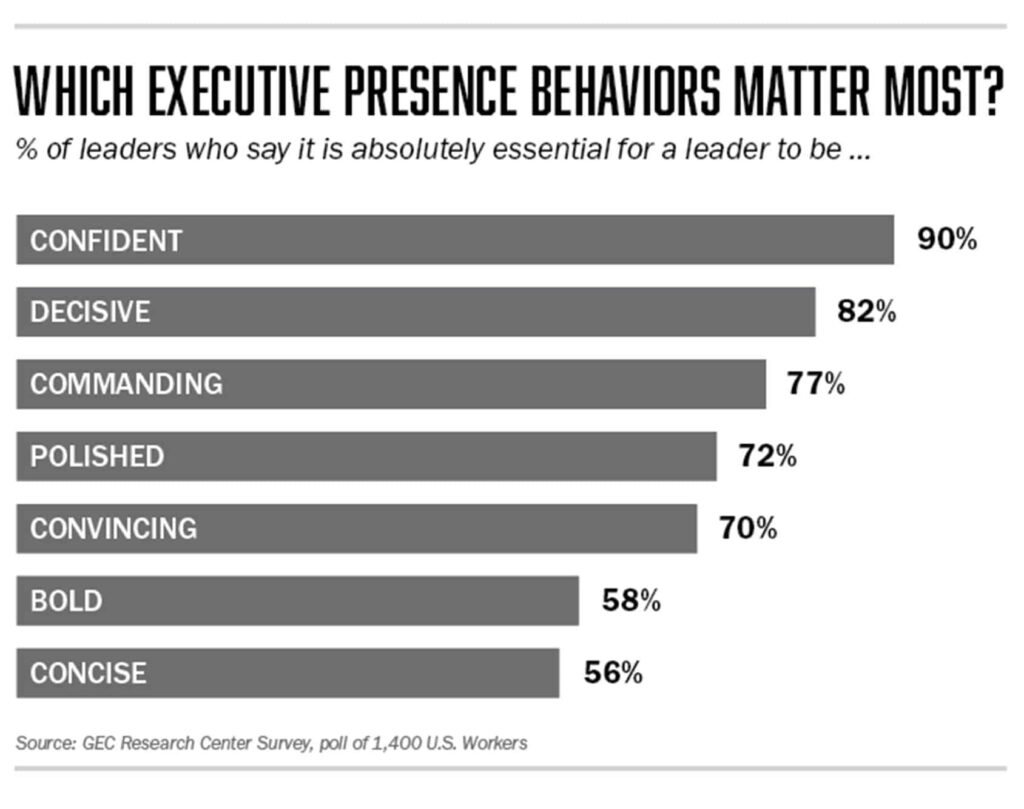7 Surprising Statistics About Executive Presence
In recent years, the increased focus on executive presence has led to the emergence of powerful insights. These executive presence statistics demonstrate the importance of executive presence for leaders in any field.
Executive presence statistic #1 – showing the importance of executive presence
Top executives emphasize the importance of executive presence. Executive presence makes up 26% of what will take a leader to the next level, found Coqual (formerly the Center for Talent Innovation). In other words, executive presence gives leaders that critical advantage over the competition. It takes them from being technically qualified to equipped to inspire and coach a team to success, playing a crucial role in professional advancement.
Executive presence statistic #2 – how to get executive presence
Most leaders have to grow executive presence; few people are naturally imbued with a full set of executive presence qualities. According to Sally Williamson & Associates, 98% of leaders must develop executive presence—they weren’t born with it. Developing executive presence takes persistent work. Enlisting the help of a skilled executive presence coach can bring noticeable results within weeks and a big transformation within months, followed by continuous fine-tuning of executive presence qualities.
Executive presence statistic #3 – revealing the foundation of executive presence
67% of senior leaders believe gravitas is the most important quality of executive presence, Coqual found. This means exuding confidence and staying calm under pressure, maintaining a strong reputation, and radiating belief in a vision.
This aligns with the findings of GEC Research Center, which characterizes gravitas as having your thoughts, ideas, and actions carrying a weight. People can feel your presence immediately. In our research with 1,400 executive coaching clients and 7,500 workshop participants, authority and expression clearly emerged as the other two pillars of executive presence. Authority encompasses how you act, and expression involves how you communicate.
Executive presence statistic #4 – the top 3 qualities of executive presence
Leaders consider “Confident,” “Decisive,” and “Commanding” to be the top three qualities of executive presence. To radiate any other skills or attributes, leaders must have confidence. Being decisive is essential for getting anything done; inaction will quickly brand a leader as incompetent. And being commanding by taking charge of meetings and situations demonstrates a leader’s power and presence.
Executive presence statistic #5 – women and people of color in leadership
Women and people of color are often held to higher standards in terms of executive presence, all while receiving less support in cultivating it.
The majority of top-level leaders are men, and they tend to give much more feedback to male subordinates. This means promising women are left out. While 48% of men have received detailed career advice from a mentor in the past two years, only 15% of women have received this guidance, the Working Mother Research Institute reports.
In “Cracking the Code That Stalls People of Color,” Sylvia Ann Hewlett reports that 56% of people of color report being held to higher standards than white colleagues, in terms of executive presence. They feel less clear on how to respond to feedback on their leadership abilities (only 37% of white professionals feel unclear about this, compared to 84% of Asians, 80% of Hispanics, and 69% of African Americans). And only 8% of professionals of color have a sponsor, compared to 13% of whites.
But for POC professionals and women, executive presence can be a secret weapon for advancement, once they adopt strategies for developing it.
Executive presence statistic #6 – the qualities that most undermine executive presence
The GEC Research Center also uncovered the behaviors that most undermine leaders’ executive presence. Leaders commonly engage in these behaviors without realizing how greatly they’re affecting their career success. I call these “but” behaviors—the behaviors that cause executives to say, “I’d love to promote you, but…” Leaders ranked “indecisive” (88%), “timid” (85%), “lacking confidence” (84%), “too verbose” (75%), and “quiet” (72%) as the behaviors that most undermine executive presence.

These statistics on executive presence deliver powerful insights about why executive presence is so critical, the most important qualities to develop, and the qualities to avoid. They also highlight that in light of societal injustices that still prevail in the workplace, women and people of color can focus on cultivating executive presence to get ahead. Working with a good coach will provide the insight and guidance that may be lacking in relationships with senior leaders.
An experienced coach will help you implement strategies for immediately beginning to enhance your executive presence. Contact Joel to start an executive presence coaching program focused on your needs or an executive presence training program for your company. You can also purchase his book for your employees: Executive Presence: Step into Your Power, Convey Confidence and Lead with Conviction.
Sources:
Coqual, “Executive Presence”
Harvard Business Review, “What Men Can Do to Be Better Mentors and Sponsors to Women”
Sally Williamson & Associates. n.d. “Executive Presence Is a Top Priority for Leadership.”
Sylvia Ann Hewlett, “Cracking the Code That Stalls People of Color,” Harvard Business Review
|

